New publications
Plants
Dischidia
Last reviewed: 29.06.2025
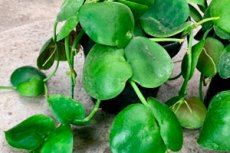
Dischidia (Dischidia) — a genus of plants in the Gesneriaceae family, consisting of about 30 species. These plants are epiphytes, commonly found in the tropical forests of Southeast Asia, Australia, and Oceania. Dischidias are vines that can cling to trees or other supports using their stems and roots. The plants have an interesting adaptation, forming specialized leaves that store water. Some species have such decorative and unique leaves that they are often used in indoor landscaping and landscape design.
Characteristics of dischidia
Dischidias have thick, fleshy leaves that serve as reservoirs for water and nutrients. The plant can survive short periods of drought due to these reserves. The flowers of dischidia are small but quite striking, and they can be white, yellow, or pink, forming inflorescences at the tips of the shoots. In indoor conditions, dischidia is often grown as a trailing plant and is ideal for hanging pots.
Etymology of the name
The genus name "Dischidia" is derived from the Greek words "dis" meaning "double" and "khidion" meaning "fruit," which may refer to the characteristic structure of the fruit in some species, which forms two small bulbs on the stem. This fruit structure allows the plant to disperse more effectively in its natural habitat, as well as giving the plant an interesting and unusual appearance.
Life form
Dischidias are epiphytic or sometimes lithophytic plants, meaning they can grow on trees or rocks without harming their hosts. Most species have creeping stems that can weave around trees, forming dense foliage. In nature, they often use other plants as support, but they do not parasitize them like some other epiphytes do.
It is also important to note that dischidias have a unique adaptation for surviving in conditions of insufficient moisture. Water accumulates in their fleshy leaves and stems, allowing the plant to withstand droughts. This feature makes dischidia particularly popular among plant enthusiasts who want an exotic plant that requires minimal care.
Family
Dischidia belongs to the Gesneriaceae family, which includes more than 140 genera and around 3,000 species. This family is known for its ornamental plants, with popular genera like Aconitum, Gloxinia, and Columnea. Gesneriaceae species are capable of surviving in tropical forests, often in the shade beneath the tree canopy, making them ideal candidates for growing in environments with moderate light.
Plants in the Gesneriaceae family are characterized by fleshy leaves, vibrant flowers, and specific care requirements. Dischidias, like other members of this family, prefer a humid environment and adapt well to indoor conditions.
Botanical characteristics
Dischidia plants are perennials with a characteristic vine-like growth form. They have soft, fleshy, succulent leaves that can be round or heart-shaped, depending on the species. These leaves may also be covered with a light waxy coating, which helps retain moisture. Some species have decorative variations in leaf color, such as white or yellow spots, making them highly attractive as houseplants.
Dischidia flowers are usually small and not very noticeable, but they may have a pleasant scent. These plants can form both solitary and clustered flowers, which appear during certain seasons. Additionally, dischidias have small fruits that may have a white or yellowish coating, one of their characteristic features.
Chemical composition
The chemical composition of dischidias has not been extensively studied, but it is known that these plants contain various organic acids and enzymes that help maintain moisture within their leaves. These substances likely aid the plant in coping with the high temperatures and humidity of tropical forests, where they grow.
It should also be noted that dischidia is an epiphyte, and its leaves act as water reservoirs. In some species, compounds are found that help retain moisture and stimulate cell growth.
Origin
Dischidia is native to the tropical and subtropical regions of Southeast Asia, Australia, and some Pacific islands. It is found in the wild in countries such as Malaysia, Thailand, Indonesia, and the Philippines. These plants prefer humid forests, where they can grow in the shade, attaching to trees or rocks.
Many species of dischidia have adapted well to indoor cultivation conditions and have been introduced to Europe and America as ornamental plants. They have recently become quite popular among exotic plant lovers and collectors.
Ease of growing
Dischidias are relatively easy to grow if a few basic rules are followed. These plants thrive in moderately warm and humid conditions. It is important to remember that dischidia grows best with good drainage and proper watering. As epiphytes, they prefer high humidity but cannot tolerate stagnant water in the soil.
Growing dischidia is suitable even for beginner gardeners. The key is to choose the right location for the plant, ensuring it receives adequate humidity and warmth. They can be grown as trailing plants in hanging pots, making them convenient for decorating spaces.
Species and varieties
Dischidia has many species, among which several popular varieties can be highlighted:
Dischidia Million Hearts
This variety got its name due to the shape of the leaves, which resemble small hearts. The leaves have a rich green color with a characteristic velvet-like texture. Unlike many other dischidia varieties, this one has a fairly compact growth form, making it ideal for growing in small pots or hanging baskets. The plant grows actively, and its decorative qualities make it one of the most popular species in collections.
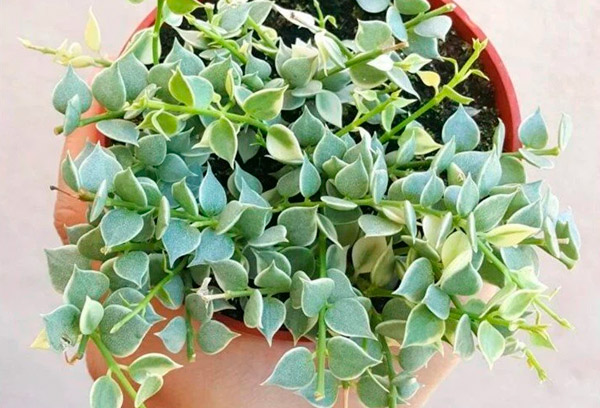
Dischidia Variegata
This variety is distinguished by its bright, variegated (mottled) pattern on the leaves. The leaves of the variegated dischidia often have light green or cream spots on a dark green background, giving the plant an unusual, attractive appearance. This variety is well-suited for creating decorative compositions in hanging baskets or balconies, and it adapts well to indoor conditions.
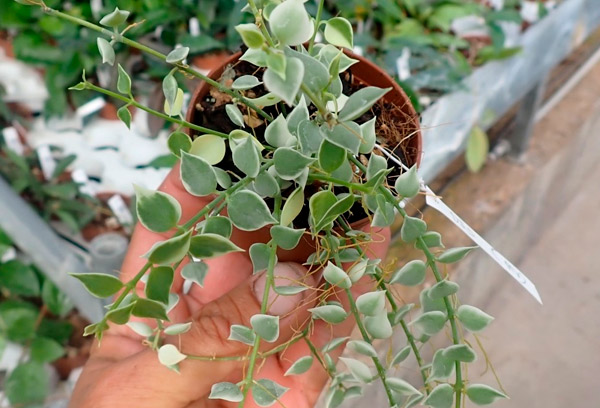
Dischidia Nummularia
Dischidia nummularia is one of the most well-known species, characterized by round, almost coin-like leaves. This variety is often referred to as the "coin dischidia." It grows slowly and forms compact clumps, making it an excellent choice for small containers and terrariums. The leaves are green with a shiny surface and may be slightly fleshy.
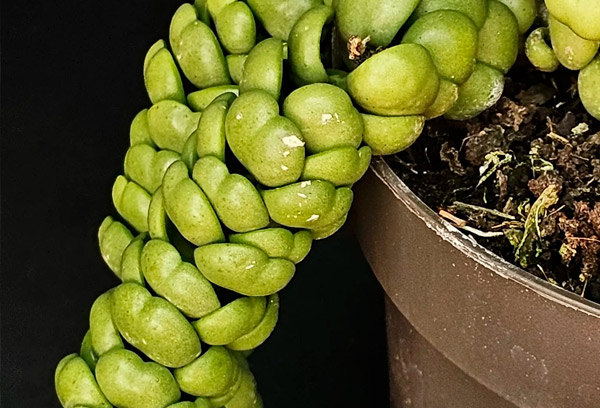
Dischidia Hirsuta
Dischidia hirsuta has unique leaves covered with soft hairs, giving them a rough texture. This epiphytic plant grows fairly quickly and can form dense clumps. The leaves are oval-shaped and are dark green in color. The flowers of this variety are inconspicuous, but the plant's appearance is quite interesting.
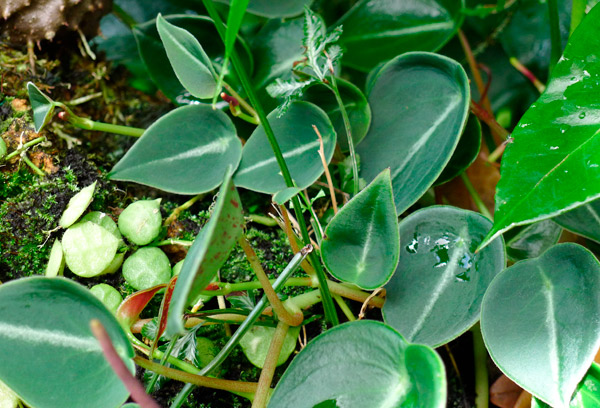
Dischidia Iolanta
Dischidia iolanta is a rare species with bright, decorative leaves that can be oval or heart-shaped. The plant grows quite quickly, with a characteristic drooping growth habit, and is used as a trailing plant. This variety is quite hardy and can adapt to various lighting conditions.
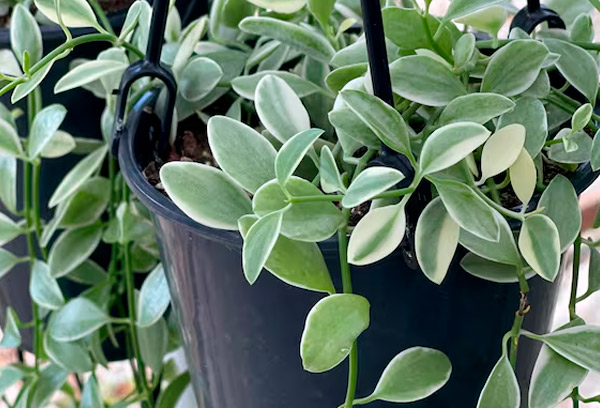
Dischidia Snail
Dischidia snail is an interesting variety with narrow leaves that resemble the shape of snail shells. The leaves can have a greenish or silvery color with a slight metallic sheen. This plant grows quickly and forms dense foliage, making it an excellent choice for hanging compositions.
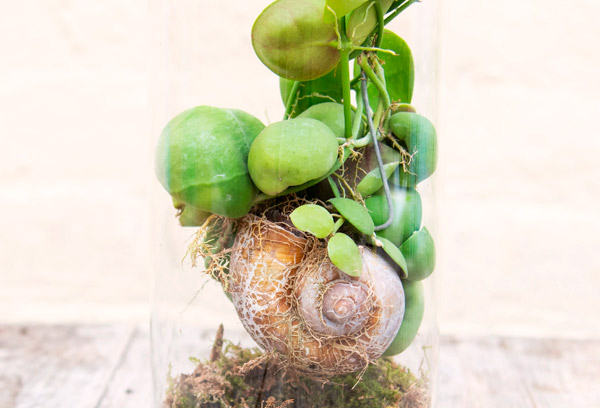
Dischidia Pectinoides
The pectinoides variety has long, narrow leaves that grow in dense clusters. This dischidia species is often used for decorative purposes due to its unique leaves and adaptability to various growing conditions. The flowers of this plant are white with a yellow center and are quite decorative.
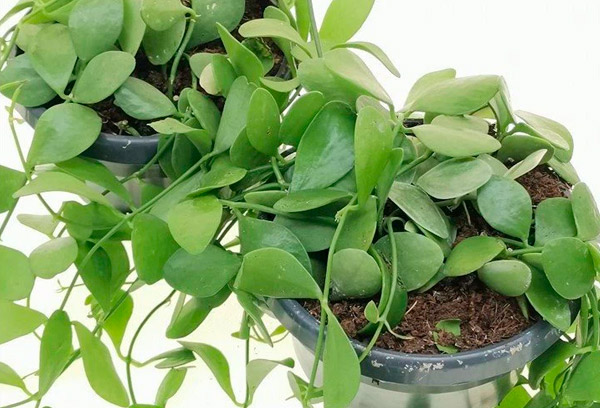
Dischidia Russifolia
Dischidia russifolia has large leaves, often round and smooth. The plant grows slowly but forms beautiful decorative clumps. The leaves may be thicker than those of other species, giving the plant a denser structure.
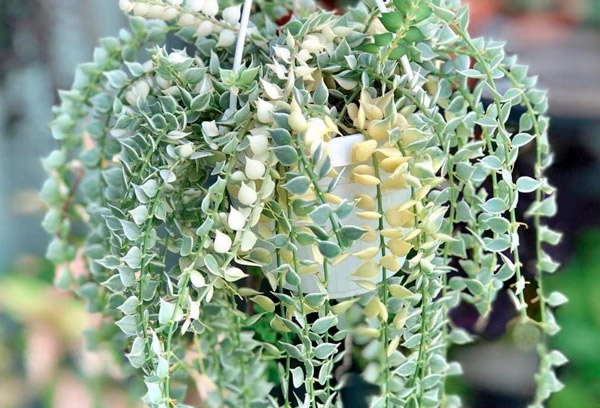
Dischidia Singulares
This variety has elegant, elongated leaves that give the plant a more slender and stretched appearance. Dischidia singulares is a slow-growing plant that prefers moderate conditions and shade. It adapts well to indoor environments and is often used as decoration.
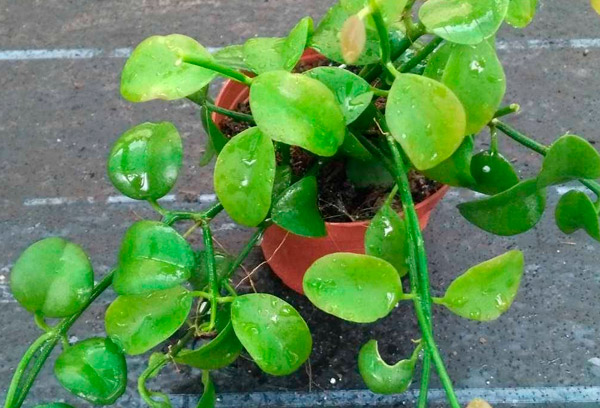
Dischidia Ovata
Dischidia ovata is characterized by round, dense leaves that are gathered into dense clumps. This plant forms lush shoots and looks great in hanging containers. It tolerates low light conditions well, making it ideal for growing in rooms with limited sunlight.
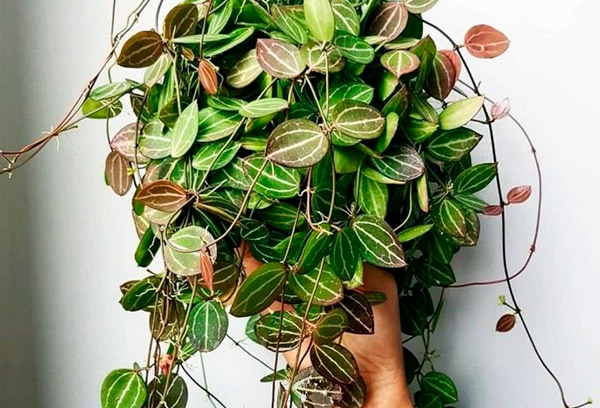
Dischidia Cleistantha
This plant has unique leaves with a characteristic white edge. Dischidia cleistantha can reach considerable sizes, forming long vines that hang beautifully in hanging pots. It is one of the most decorative species, used to create exquisite compositions.
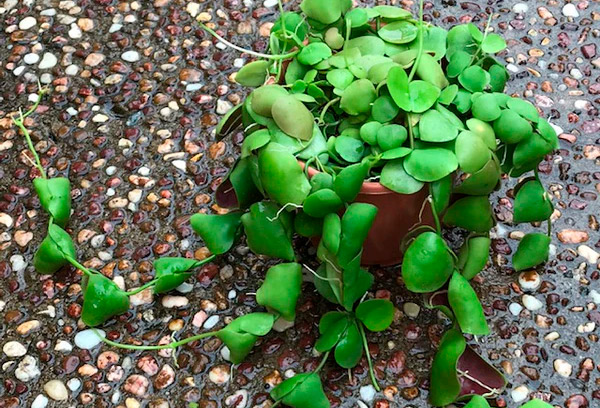
Dischidia Major
Dischidia major features large leaves that can reach significant sizes. It is a fairly robust plant that grows quickly and is an excellent choice for creating lush trailing compositions. It prefers bright but diffused lighting.
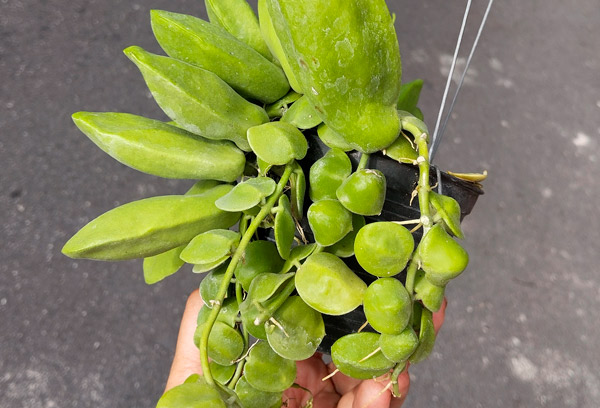
Dischidia Imbricata
Dischidia imbricata has dense, overlapping leaves that form a unique roofing pattern. This plant grows actively and is suitable for growing in hanging pots. The leaves are round or oval and create a stunning green screen effect.
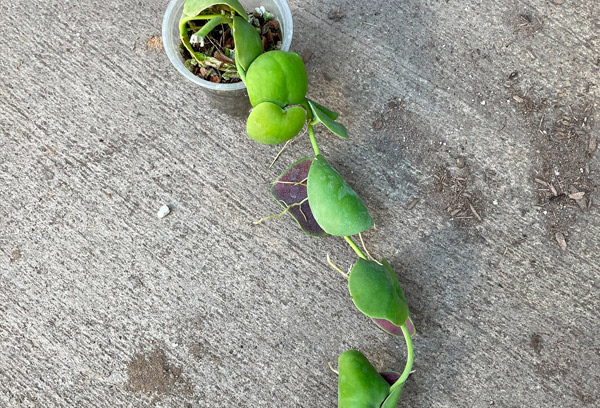
Dischidia Watermelon
This variety got its name due to its characteristic leaves that resemble the texture and coloration of a watermelon. The leaves can be light green with dark stripes, making the plant unusual and attractive. This variety grows well in hanging compositions.
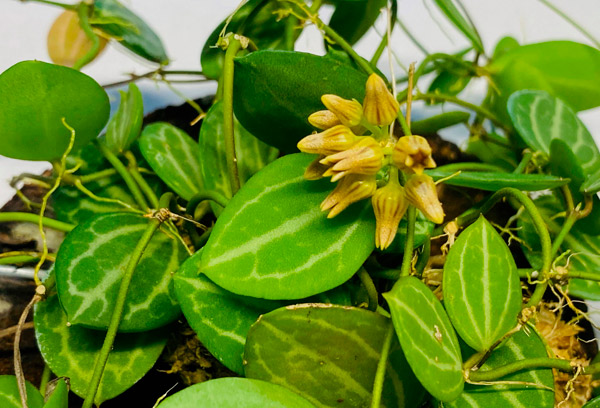
Dischidia Melon
Dischidia melon draws attention with its round leaves that have a characteristic net-like texture. It grows slowly but tolerates a variety of conditions, including shade and low humidity. The plant's flowers are often yellow or white and can form beautiful clusters.
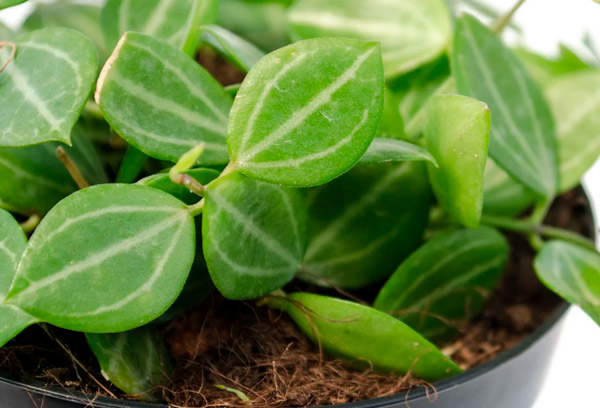
Dischidia Platyphylla
Dischidia platyphylla is a compact plant with broad leaves that grow on short stems. It is highly decorative and has a beautiful green color. It is an excellent choice for small spaces or terrariums where an exotic atmosphere is needed.
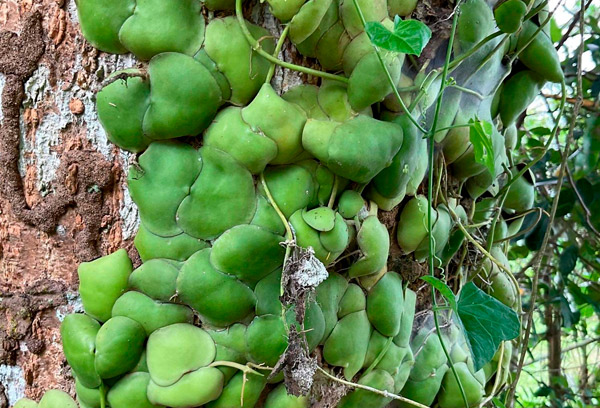
Dischidia Hoya
This variety is a hybrid between dischidia and hoya. The leaves of Dischidia hoya are fleshy, dense, and slightly waxy with fine veins, creating an interesting texture. This variety is known for its abundant flowering, which consists of white or cream flowers gathered in racemose inflorescences.
Other species include Dischidia Snail, Dischidia Pectinoides, Dischidia Russifolia, Dischidia Singulares, Dischidia Ovata, Dischidia Cleistantha, and many more.
Size
Dischidia plants vary in size depending on the species and growing conditions. Some species, like Dischidia Nummularia, can grow up to 1.5 meters in length, while other varieties, such as Dischidia Hoya, remain more compact. However, all dischidias have a creeping or trailing growth form, making them ideal for hanging pots or baskets.
The size of the plant also depends on its age. Young plants typically have smaller leaves, but as they grow, the leaves increase in size, contributing to a lush and dense foliage.
Growth rate
Dischidia grows fairly slowly, especially if the plant does not receive enough light or moisture. Usually, these are epiphytic plants that do not require rapid growth to feel comfortable. Under ideal conditions with optimal humidity and light, dischidia can significantly increase its size during one growing season.
However, excessive watering or insufficient light can slow down its growth, and improper conditions for propagation can cause growth to stop.
Lifespan
Dischidias can live for many years with proper care. Some species can delight their owners with their leaves and flowers for many years. If the plant receives adequate water, warmth, and light, it will grow and bloom without any major issues. However, drastic changes in conditions or improper care can shorten the plant’s life.
Maintaining the correct conditions and providing regular care will help the plant live long and stay healthy.
Temperature
Dischidia prefers warm conditions, with temperatures between 20 and 28°C (68-82°F). The plant cannot tolerate frost and should not be placed on a balcony during cold months. It is also important to avoid sudden temperature changes, as this can stress the plant and lead to diseases.
Temperatures below 15°C (59°F) can be critical for the plant, so in winter, it should be placed in warm rooms protected from drafts.
Humidity
As an epiphyte, dischidia requires high humidity for optimal growth. The ideal humidity level for this plant is between 60-80%. In dry environments, it is recommended to use humidifiers or regularly mist the leaves to maintain the necessary moisture level.
If the humidity is too low, the leaves may begin to dry out, and the plant’s growth will slow down. In such conditions, it is important to increase the humidity or move the plant to a more suitable location.
Lighting and placement
Dischidia prefers bright but diffuse lighting. Direct sunlight can damage the leaves, so it is better to place the plant in the shade or on east or west-facing windows. It is important to ensure that the plant does not receive too much direct sunlight, as this can cause the leaves to burn.
A great place for dischidia would be a hanging pot or basket in a corner of the room where it will be protected from direct sunlight but still receive enough light to grow.
Soil and substrate
For growing Dischidia, it is recommended to use a loose, well-drained substrate. An ideal mix consists of leaf soil, peat, sand, and perlite in a 2:1:1:1 ratio. Peat helps retain moisture, while sand and perlite provide good drainage, preventing water stagnation, and the leaf soil serves as an organic matter source, providing necessary nutrients for the plant. The recommended pH for Dischidia soil is 5.5–6.5, which is moderately acidic or neutral, suitable for most species of this plant. It's also important to ensure good drainage in the pot to avoid water stagnation and root rot.
Watering
Dischidia prefers moderate watering. It's important to remember that this plant does not tolerate standing water, so the soil should be slightly moist, not soggy. Water the plant when the top layer of soil dries out, especially in winter when growth slows down. Avoid overwatering, as this can lead to root rot.
In warm weather, when the plant is growing and actively developing, you can water it slightly more often, but be sure to check that water does not remain in the saucer, as this can cause root rot. The best option is to water with room-temperature water.
Fertilizing
Dischidia can be fertilized from spring to autumn. It is recommended to use fertilizers for ornamental foliage plants that contain all necessary macro- and micronutrients. Fertilizers can be applied once a month using water-soluble complex fertilizers. This helps the plant maintain healthy growth and vibrant leaf coloration.
In winter, when the plant's growth slows down, fertilizing is not necessary, as Dischidia is not actively developing during this period. Winter fertilization can lead to excess nutrients and root burns.
Propagation
Dischidia is best propagated by cuttings, which can be done in spring or summer. A healthy shoot tip with several leaves is cut from the plant. The cuttings root in water or a moist substrate. They root faster in water, usually within 2–4 weeks, while rooting in soil takes longer, about 6–8 weeks. You can also propagate the plant by division, carefully separating part of the shoots with roots from the adult plant and transplanting them into a separate container.
Some Dischidia species, like Dischidia hirsuta and Dischidia nummularia, propagate well through cuttings, while other species may require more complex conditions for rooting. Growing from seeds is possible, but it takes a long time and patience, as Dischidia seeds germinate very slowly.
Flowering
Dischidia flowers typically in summer. However, for successful flowering, the plant requires warm conditions, bright but diffused lighting, and sufficient watering. The flowers are small, white or pink, and often form racemose clusters. Flowering can last several weeks, but in low-light conditions or with poor care, the plant may not flower for a long time.
To stimulate flowering, it is important to maintain the proper balance of lighting, temperature, and humidity and to monitor the plant's health, addressing any diseases or pests that may interfere with bud formation.
Seasonal features
In spring and summer, Dischidia is in its active growth phase and requires more attention. During this time, the plant needs regular watering, fertilizing, and sufficient lighting. In autumn and winter, growth slows down, and watering can be reduced, while fertilization should stop. It is also important to provide sufficient humidity and avoid sharp temperature fluctuations, as the plant is more sensitive to unfavorable conditions at this time.
Care features
Dischidia does not require complex care, but it is important to remember that it is an epiphytic plant that naturally grows on trees, using them as support. Therefore, in indoor conditions, Dischidia will do better if hung in hanging baskets or placed on high shelves from which it will cascade.
Regularly check the roots and leaves for diseases and pests. In winter, when humidity decreases in indoor environments, it is helpful to occasionally mist the leaves with water.
Indoor care
Dischidia prefers moderately warm conditions and high humidity. The ideal temperature for this plant ranges from 22 to 28°C in summer and from 18 to 22°C in winter. It's important to ensure that the plant is not placed in drafty areas or exposed to sharp temperature fluctuations.
The soil for Dischidia should be well-drained, and the container should be large enough to allow the roots to grow freely. To maintain the necessary humidity, especially in winter, it is useful to use humidifiers or place a shallow dish with wet pebbles next to the plant.
Repotting
Repot Dischidia every 1–2 years when the roots fill the pot. Choose a pot that is a few centimeters larger in diameter than the previous one, but not too large, so that the roots can grow more effectively. Plastic or clay pots with good drainage holes work best.
The best time for repotting is in spring when the plant is actively growing. Repot the plant if the roots start emerging from the drainage holes or if the soil in the pot is depleted.
Pruning and shaping
Pruning Dischidia is not mandatory, but it helps keep the plant compact and stimulates branching. Pruning should be done at the end of winter or early spring. Remove dry, damaged, or old shoots so that the plant continues to grow healthy and beautiful. To shape the crown, you can trim the tips of the shoots to stimulate the growth of side branches.
Common problems and solutions
Diseases: One of the common problems with Dischidia is root rot, especially if the plant is overwatered or the soil dries out too much. To prevent this, it's important to maintain a proper watering routine and ensure good drainage.
Nutrient Deficiency: A lack of fertilizers can lead to yellowing leaves and slowed growth. In this case, start regular fertilization with complex fertilizers.
Care Mistakes: Overwatering and insufficient light are the main mistakes that can affect the plant's health.
Pests
Dischidia can be attacked by pests such as spider mites, aphids, scale insects, and mealybugs. Spider mites often appear in dry air conditions, while aphids and scale insects may come with other plants. To combat these pests, regularly inspect the leaves and stems for signs of damage. If pests are detected, you can use insecticidal soap solutions or specialized chemical products. Natural remedies, such as garlic, pepper, or citrus infusions, are also effective.
Prevention includes maintaining optimal humidity and temperature in the room, regularly cleaning the leaves from dust, and using barrier methods, such as isolating new plants in quarantine before introducing them to the general interior. This helps avoid transferring pests from other plants.
Compatibility with other plants
Dischidia pairs well with other epiphytes and trailing plants such as ivy, stephanotis, or chlorophytum. It can also be placed near other ornamental foliage plants with similar growing conditions, such as ficuses or ferns. It is important to choose plants with similar light, temperature, and humidity requirements to ensure harmonious growth for all members of the "plant community." Avoid placing Dischidia next to plants that require heavy watering or cold temperatures.
Air purification
Like many other indoor plants, Dischidia has the ability to purify the air from harmful substances. It helps improve air quality by removing toxins such as formaldehyde and xylene, contributing to a healthier environment. This plant can be a great addition to interiors, not only improving their appearance but also contributing to overall air purification in the home or office.
Safety
Dischidia is not a toxic plant and does not pose a threat to pets or humans. However, as with any plant, it's important to avoid ingesting its parts, as this can cause mild stomach discomfort. Special caution should be taken with children who might accidentally swallow leaves or fruits. Allergic reactions to the plant's pollen or sap are very rare, but it's always wise to handle the plant carefully.
Wintering
Wintering Dischidia requires special attention as the plant slows its growth and rests during this period. It's important to reduce watering to avoid stagnant moisture and root rot, while the temperature in the room should not drop below 18°C. Lighting should be bright but diffused to avoid leaf damage from direct sunlight. You can also increase humidity by using humidifiers or placing trays with pebbles and water.
During wintering, Dischidia does not require fertilization. This is the plant's recovery time, so active actions such as pruning or repotting should be avoided. Simply keep the plant in comfortable conditions, monitoring the humidity, especially in the heating season, to avoid drying out.
Beneficial properties
Although Dischidia is not a well-known medicinal plant, it has beneficial properties related to its ability to purify the air and improve the indoor climate. It can be useful for people with respiratory conditions, as the plant filters harmful substances from the air, helping to improve breathing and the overall atmosphere.
Moreover, Dischidia contributes to improving psycho-emotional well-being. Observing and caring for the plant can have a relaxing and calming effect, reducing stress and improving mood. This makes Dischidia an excellent plant for creating a cozy and healthy atmosphere at home.
Use in traditional medicine or folk remedies
In folk medicine, Dischidia does not have widespread use, but in some cultures, its leaves have been used to prepare infusions and ointments for treating inflammations and skin diseases. The leaves of the plant have antiseptic and anti-inflammatory properties, making them useful in local medical practices.
However, it is important to consult a professional healthcare provider before using any plant for medicinal purposes. It is essential to remember that folk remedies cannot replace professional medical treatment, especially for serious diseases.
Use in landscape design
Dischidia, with its trailing forms, is often used in landscape design to decorate vertical surfaces and create greenery on balconies, verandas, or in hanging baskets. This plant looks great as a decoration for terraces or on walls in the form of hanging carpets, especially when combined with other ornamental foliage plants.
It can also be used to create a green wall or green curtain effect. When combined with other leafy and climbing plants, Dischidia adds a lively and cozy atmosphere to any space.
Conclusion
Dischidia is a beautiful and low-maintenance plant that makes an excellent addition to any interior. Not only does it decorate rooms with its bright leaves and decorative forms, but it also purifies the air, improving the indoor microclimate. With proper care, Dischidia will delight its owners with its beautiful appearance for many years.
Its resilience to a variety of conditions and minimal care requirements make it a popular choice among both experienced and beginner gardeners. Whether you decide to use Dischidia as a decorative element in your home or as part of a green composition in your garden, this plant will undoubtedly become a true ornament in any space.
